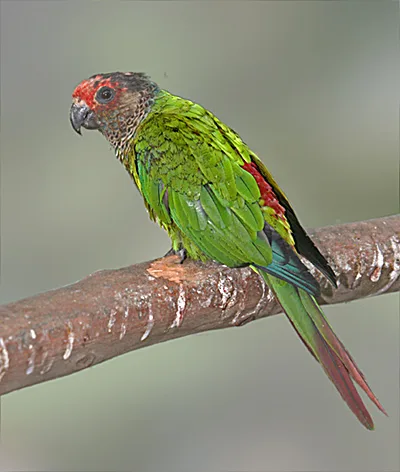
Rose-fronted Parakeet
Subspecies
Monotypic species
Genus
The genus Pyrrhura includes a rich set of small to medium-sized species of parakeets, mostly confined to dense habitats in South America. Also, they inhabit dry as well as tall rainforests which occur from sea level up to 2000m. These birds exploit several tree species and use a variety of food items, from nectar to pure seeds. All have long, pointed tails, a mainly green plumage, and a relatively narrow, dark greyish to white eye-ring. Many have scaly or barred chest-patterns and a whitish, pale grey, buff or reddish ear-patch. They typically move around in small, noisy flocks, flying swiftly at or below canopy level. Once settled in a tree they tend to be silent (especially if aware of danger) and difficult to spot. They nest in a tree-crevice.
Physical charateristics
Listen to the sound of Rose-fronted Parakeet
[audio:https://planetofbirds.com/MASTER/PSITTACIFORMES/Psittacidae/sounds/Rose-fronted Parakeet.mp3]
Copyright remark: Most sounds derived from xeno-canto
recorded by David Geale
| wingspan min.: | 0 | cm | wingspan max.: | 0 | cm |
| size min.: | 22 | cm | size max.: | 24 | cm |
| incubation min.: | 0 | days | incubation max.: | 0 | days |
| fledging min.: | 0 | days | fledging max.: | 0 | days |
| broods: | 1 | eggs min.: | 5 | ||
| eggs max.: | 7 |
Range
Habitat
Reproduction
Feeding habits
Video Rose-fronted Parakeet
copyright: swordbilledexp
Conservation
The taxonomy and nomenclature of Pyrrhura parakeets are complicated. The current classification of the Rose-fronted Parakeet is a good example of this confusing state of affairs. Rose-fronted Parakeet for many decades was classified as a subspecies of the Painted Parakeet (Pyrrhura picta), although the extensively red head of roseifrons makes its appearance seem very different from that of most members of the picta group.
Migration
Distribution map

